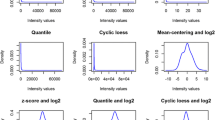Summary
Microarray analysis has become a core part of biomedical research and its value can be seen in thousands of research papers. A successful microarray experiment needs to be augmented by specialized data mining techniques if the data are to be fully exploited. Here, tools that concentrate on three areas – gene enrichment analysis, literature mining, and transcription factor binding site analysis – are described for the novice user of microarray technology. The focus of this chapter is on free, publicly available, web-based tools.
Access this chapter
Tax calculation will be finalised at checkout
Purchases are for personal use only
Similar content being viewed by others
References
Curtis, R. K., et al. (2005). Pathways to the analysis of microarray data. Trends Biotechnol 23, 429–435
Dennis, G., Jr., et al. (2003). DAVID: Database for Annotation, Visualization, and Integrated Discovery. Genome Biol 4, P3
Jensen, L. J., et al. (2006). Literature mining for the biologist: from information retrieval to biological discovery. Nat Rev Genet 7, 119–129
Becker, K. G., et al. (2003). PubMatrix: a tool for multiplex literature mining. BMC Bioinformatics 4, 61
Hoffmann, R., et al. (2004). A gene network for navigating the literature. Nat Genet 36, 664
Elnitski, L., et al. (2006). Locating mammalian transcription factor binding sites: a survey of computational and experimental techniques. Genome Res. 16, 1455–1464
Loots, G. G., et al. (2002). RVista for comparative sequence-based discovery of functional transcription factor binding sites. Genome Res 12, 832–839
Author information
Authors and Affiliations
Corresponding author
Editor information
Editors and Affiliations
Rights and permissions
Copyright information
© 2009 Humana Press, a part of Springer Science+Business Media, LLC
About this protocol
Cite this protocol
Dunbar, D.R. (2009). Gene Expression Mining in Type 2 Diabetes Research. In: Stocker, C. (eds) Type 2 Diabetes. Methods in Molecular Biology, vol 560. Humana Press. https://doi.org/10.1007/978-1-59745-448-3_17
Download citation
DOI: https://doi.org/10.1007/978-1-59745-448-3_17
Published:
Publisher Name: Humana Press
Print ISBN: 978-1-934115-15-2
Online ISBN: 978-1-59745-448-3
eBook Packages: Springer Protocols




